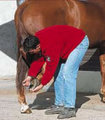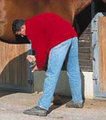Saddled with back problems
Horse riding is a sport which can sometimes give a rough time to the rider's back. His spine « absorbs » strokes and muscles are much urged. But when you evolve in the horse world, it's not only on the saddle that the back is called upon. It is often necessary to raise remarkable loads (straw and hay bales, food bags), clean the manure, treat the horse's hooves, etc. Here are some advice to avoid the « awkward movements », which can lead to a back strain and other lumbago.
CORRECTLY CARRYING
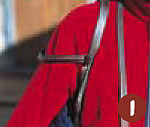
Correctly carrying your bridle :
• A right-handed person will act on the right shoulder (a left-handed will do the contrary). Pass your stretched arm between bridle and bit and slide the whole bridle towards your shoulder, where it will rest (picture 1).
Effectively carrying your saddle :
• Right-handed persons will work on the right and left-handed persons on the left. Take the saddle with upward cantle and outward seat. The cantle will rest on the right side of your body (for right-handed persons), as your arm passes under the cantle so that the hand can hold the pommel (picture 2). When walking, keep your back straight and don't lean towards the side opposite to the saddle (picture 3).
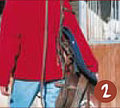
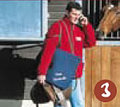
SOME ADVICE
• Carrying a straw or hay bale (in average 15 kg) on your own:
Place the hay bale vertically. Take the stirrup leather used to transport the shaving bale. Pass the stirrup leather under the two strings in the bale, balancing the matching pieces. Adopt then the same technique used to transport a shaving bale on your own.
• Carrying a straw or hay bale by two people :
Locate the bale horizontally. Each carrier must be on a side. With the nearest hand, reach the bale string, as much in the middle as possible. Be careful to always be balanced on your thighs and to keep your back straight. Push on your thighs and move yourself.
• Carrying a bucket of water :
In order to carry a bucket of water by 15 l (that is to say 15 kg), you are obliged to act as a counterbalance with your body. Consequence: by obliging the spine to form a bow, the load damages your back. It is better to equally split the weight on both sides by using two half-filled buckets. The load is the same but it is much better distributed.
CLEAN THE MANURE WITHOUT HURTING YOURSELF
The more you try to « move » the manure with a short hayfork handle, the more your back suffers, even though the movement seems more comfortable to you. Therefore, at the beginning force yourself to use the whole handle length: this will give you a better leverage (picture 1), and therefore more strength once that your arm muscles get used. The position is very similar to the one used for hooves care. It is all about leaning on your thighs keeping your back straight (picture 2). When lifting, the work is all done by the thighs and not by the back, which would arch and risk causing lumbago, or even a hernia. Once that the manure is lifted from the ground, the weight is on your arms, that's why it is important to correctly hold the hayfork.


CARRYING A LITTER BUNDLE BY TWO PEOPLE (from 20 to 25 kg)
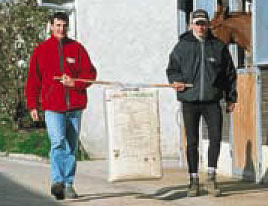
Place the bundle vertically. Slip a broomstick on its top. Make sure that each carrier has a good grip on both bundle sides to transport it.

Advantages :
• Weight is supported by two people.
• The bundle is placed so that your sight is free. There is therefore no risk to stumble.
• This technique prevents you from carrying the bundle in your arms. So, your spine remains straight.
• You have a free arm.
Cautions : You must check to be straight and not tilted on a side. That's why it is important to use an arm and not the higher part of your body as a counterbalance.
CARRYING A LITTER BUNDLE ON YOUR OWN
Tie two old stirrup leathers, then place them on the bundle as explained above.
• You will let your band pass from one bundle side to the other, upward and widthwise, checking to balance the two hanging pieces (picture 1).
• Keep the bundle behind your back and squat.
• Put a band on each shoulder and pull on them both (pictures 2 and 3).
• Block your arms, then push on your thighs. So the bundle is raised from the ground (picture 4). As usual, take care to keep your back straight (picture 5).





TO BE DEFINITELY AVOIDED
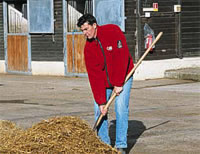
If located too low on the hayfork, the hands cannot play their leverage role. The back will arch too much. Pay attention to lumbago risks !
TAKING A HORSE'S FEET
Grooming itself is not a dangerous operation for your back. On the other hand, the step of feet care can be stressing for your back if you are in a shaky position. The comfortable position isn't always the best solution. Correct physical positions must be applied above all.
Directions for use
• Place yourself along the limb looking towards the horse's back.
• Get the same position as for a jump, that is to say squatted, leaning on thighs (picture 1), with straight and plain back supported by abdominal muscles. With your arm, ask for the horse's limb (picture 2).
Advantages
• Your back doesn't suffer.
• Your thighs muscles are stretched like springs, and this will allow you to « throw » yourself on the side in case of emergency (picture 3).
• In this position, as your feet are not under the horse's mass, you can avoid to have them treaded on.
Drawbacks
• In the first attempts, you will surely suffer from muscle contractures. It is nothing serious, your muscles will get used to their new positions and will become tougher. Within a fortnight, you will feel no difference, except a positive one, at your back level!


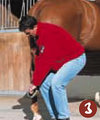
TO BE DEFINITELY AVOIDED
To take hind legs as well as forelimbs, it is important to adopt straightaway a good position. On these two photos, lower back is not enjoying itself…
